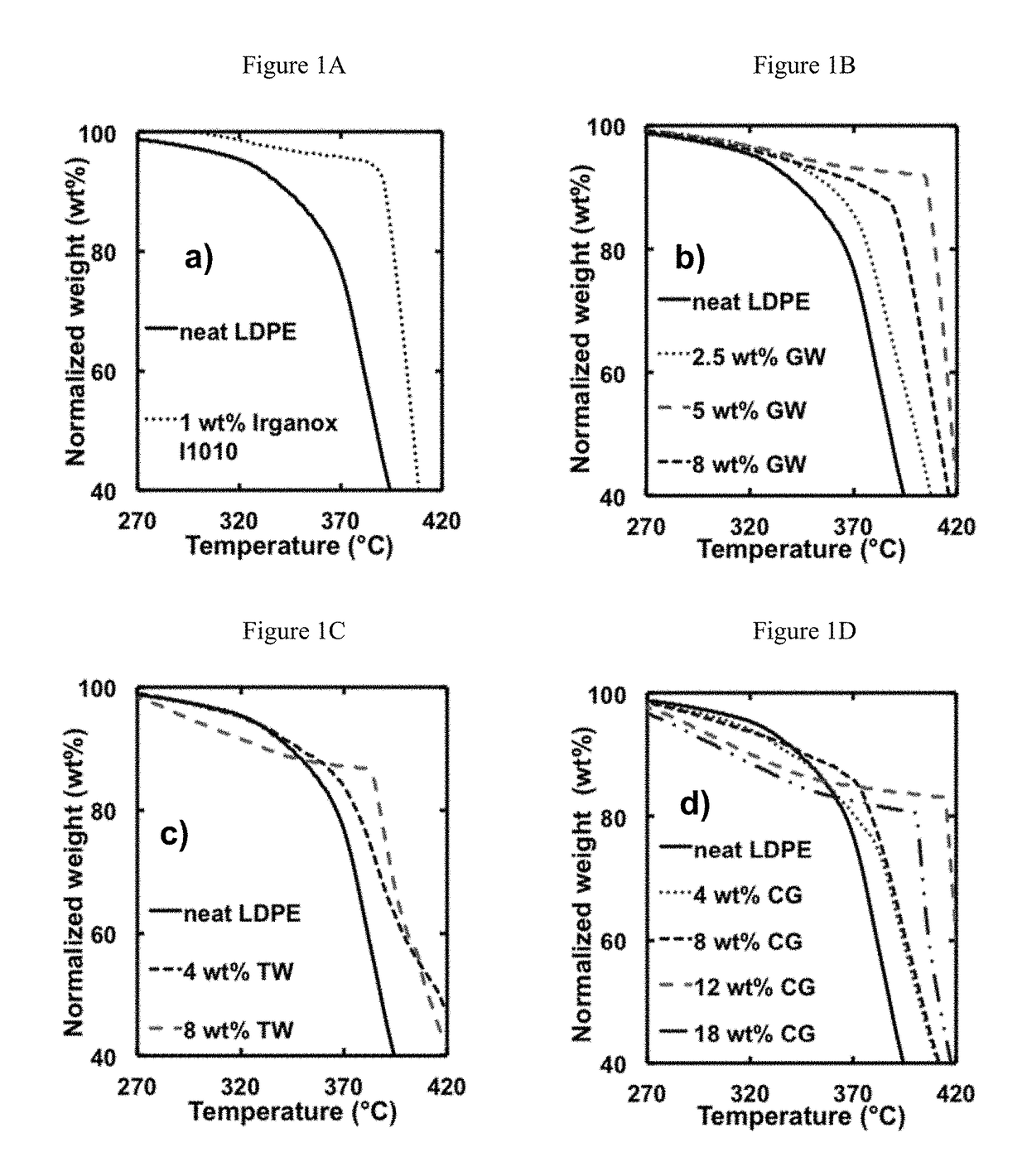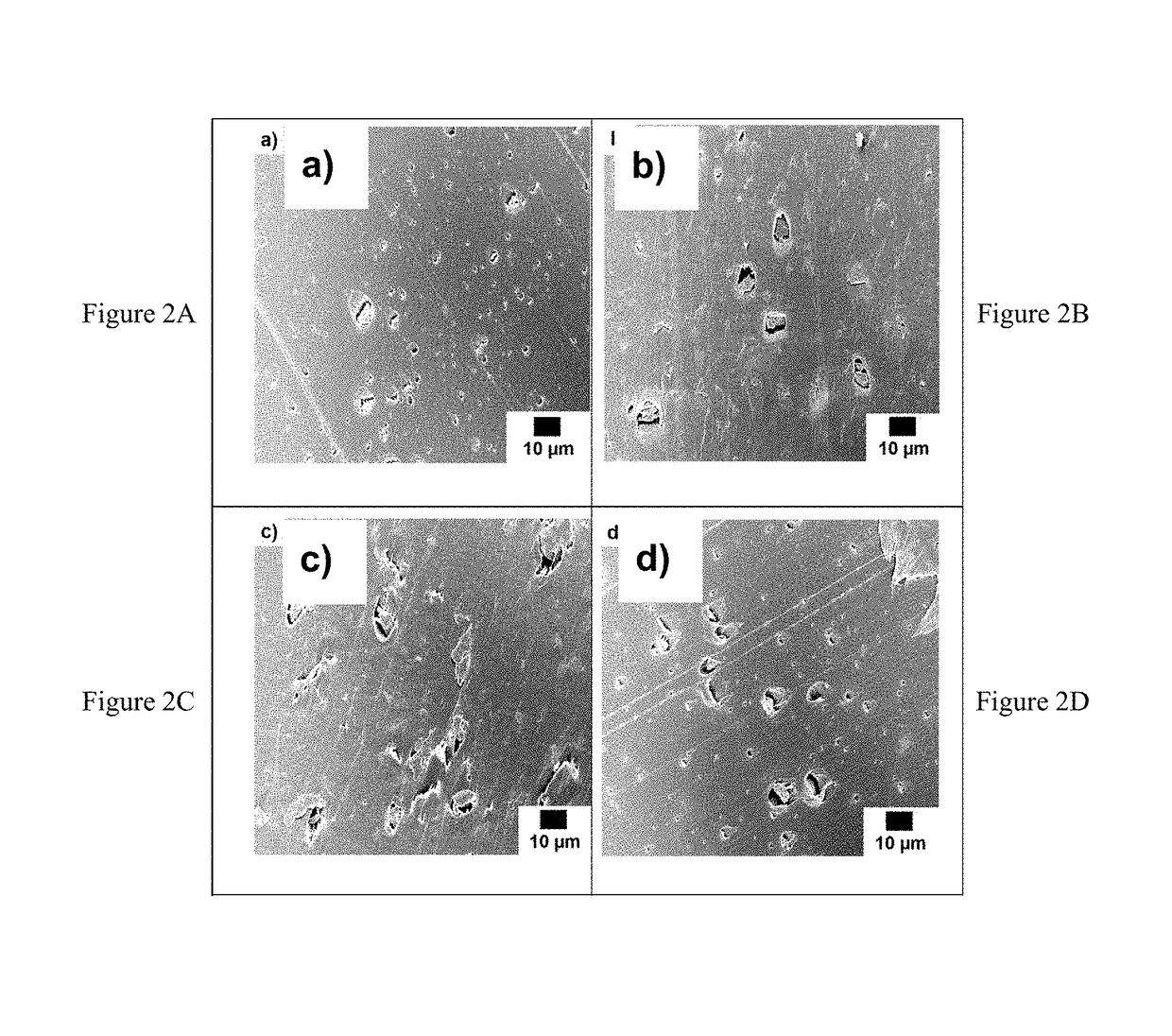Direct use of natural antioxidant-rich agro-wastes as thermal stabilizers for polymers
a technology of antioxidant-rich agrowastes and thermal stabilizers, which is applied in the field of direct use of natural antioxidant-rich agrowastes as thermal stabilizers for polymers, can solve the problems of amplifying material degradation, high oxidative degradation risk, and high temperature of polyolefins
- Summary
- Abstract
- Description
- Claims
- Application Information
AI Technical Summary
Benefits of technology
Problems solved by technology
Method used
Image
Examples
example 1
[0066]Preparation of green hybrids of LDPE / agro-waste residue. The LDPE pellets and agro-wastes were co-fed into a pilot-plant / research-scale Berstorff ZE-25 pulverizer with a K-tron S-60 feeder at a feed rate of˜100 g / h. The pulverizer barrels were cooled by a recirculating ethylene glycol / water mix (−7° C., Budzar Industries WC-3 chiller) in order to maintain the semi-crystalline (solid) state of the LDPE. The materials were processed via SSSP at high specific energy input and a 200 rpm screw speed. A sample of 96 / 4 wt % LDPE / grape pomace waste was also made using an ATLAS Electronic Devices MiniMax molder (cup-and-rotor mixer) and with three small steel balls included in the cup to achieve chaotic mixing; processing was done in the melt state at 140° C. and a rotor speed of 160 rpm. For comparison, a sample of LDPE with 1 wt % Irganox™ I1010 was prepared by melt processing at 140° C. using a Randcastle RCP-0625 microtruder. (Irganox™ I1010 was incorporated via melt mixing to draw...
example 2
[0069]Melt processing and assessment of melt stability. Polymer samples containing agro-waste (SSSP-processed) or synthetic antioxidant (melt-processed) were melt-extruded at 50 rpm using a Randcastle RCP-0625 microtruder (screw diameter=0.625 in, length / diameter=24). The three barrel zones were maintained at 140, 150 and 170° C. and the die head at 180° C. The polymer melt was cooled and pelletized. Samples of the polymer pellets were re-extruded at the same conditions up to ten extrusion cycles and were collected after second, sixth, and tenth passes. Those materials were hot pressed into discs using a PHI press (Model 0230 C-X1) at 140° C. for 5 min with 5 ton ram force. The magnitude of complex viscosity (|η*(ω)|) as a function of frequency (ω) from 0.01 to 100 s−1 was determined via small-amplitude oscillatory shear measurements (TA Instruments ARES rheometer with a 25 mm parallel plate fixture). Zero-shear-rate viscosity of samples was obtained by fitting the experimental data...
example 3
[0070]Morphological and mechanical characterization. Field-emission scanning electron microscopy (FE-SEM) samples were prepared by melting and extruding the hybrids with a MiniMax molder. Morphologies of cryo-fractured sections of the composites were obtained via a Hitachi SU8030 instrument after sputter coating (Denton Desk III) with gold. Uniaxial tensile test samples before and after extrusion were prepared by hot pressing at 140° C. for 5 min using a 5 ton ram force. Dog-bone shaped specimens were cut from films of ˜0.7 mm thickness using a Dewes-Gumbs die and tested with an MTS Sintech 2S tensile tester (ASTM D1708) with a 5 kN load cell and a crosshead speed of 50 mm / min.
[0071]As demonstrated, the direct use of antioxidant-rich agro-waste materials provides thermo-oxidative stabilizers for LDPE without the need for chemical treatment or extraction. The TGA results showed that incorporating 4 wt % GW in LDPE produced 62 and 44° C. increases in T10% and T20% relative to neat LDP...
PUM
| Property | Measurement | Unit |
|---|---|---|
| wt % | aaaaa | aaaaa |
| wt % | aaaaa | aaaaa |
| wt % | aaaaa | aaaaa |
Abstract
Description
Claims
Application Information
 Login to View More
Login to View More - R&D
- Intellectual Property
- Life Sciences
- Materials
- Tech Scout
- Unparalleled Data Quality
- Higher Quality Content
- 60% Fewer Hallucinations
Browse by: Latest US Patents, China's latest patents, Technical Efficacy Thesaurus, Application Domain, Technology Topic, Popular Technical Reports.
© 2025 PatSnap. All rights reserved.Legal|Privacy policy|Modern Slavery Act Transparency Statement|Sitemap|About US| Contact US: help@patsnap.com



